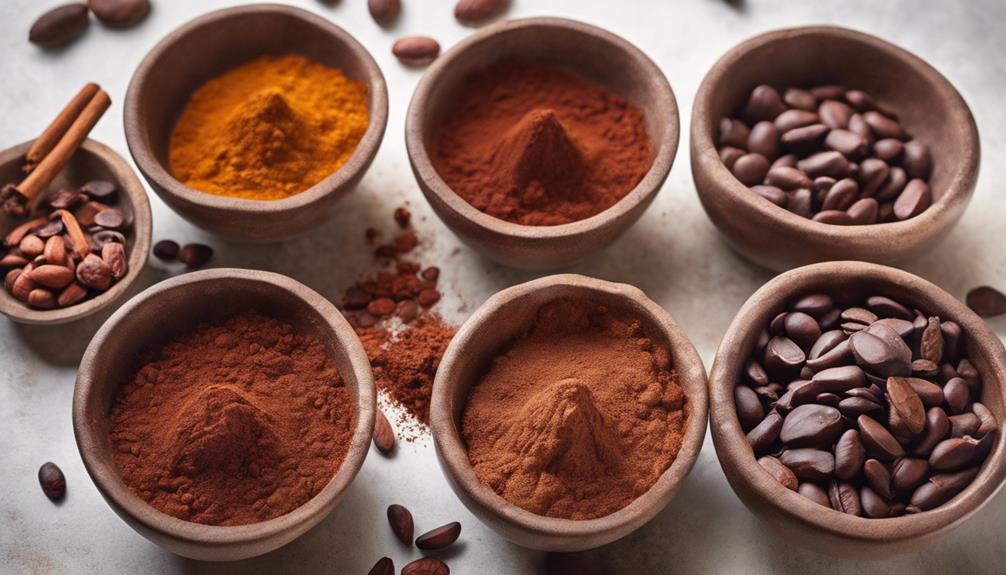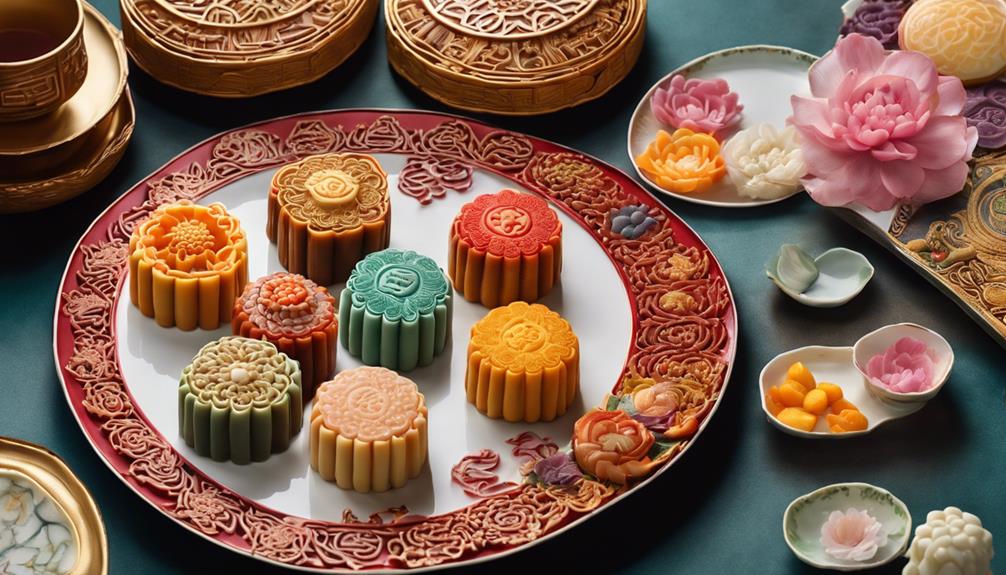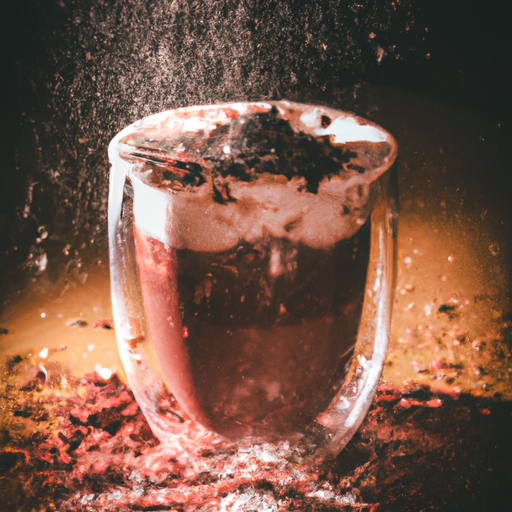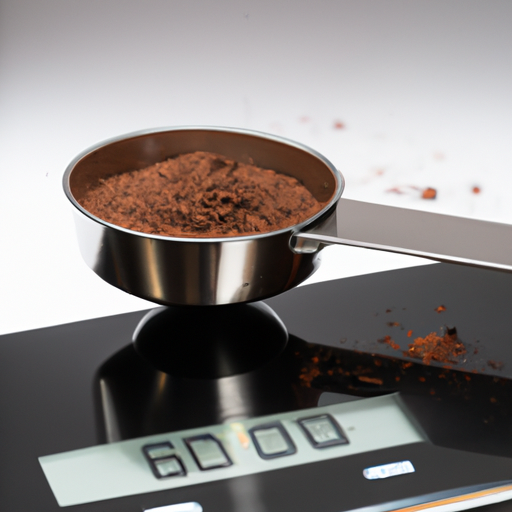To create ceremonial cacao in a simple way, you need chopped or grated cacao, liquid, sweeteners, a ceremonial cup, and quality cacao. Heat the water to 170 degrees Fahrenheit for a perfect blend. Carefully select about 25g of cacao per person, then mix it with the liquid for a creamy beverage. Include sweetener to boost the taste. Before sipping, remember to set a meaningful intention for a more fulfilling experience. Establish your intention for the ceremony by setting clear goals. If you want to make the most out of this experience, follow these steps closely.
Infuse each sip with heartfelt intentions, savoring the rich flavors mindfully. Embrace the heart-opening benefits of ceremonial cacao, stimulating creativity and focus around the heart. The journey is just beginning, hinting at deeper connections and experiences awaiting those who engage in this ceremonial cacao practice.
Key Takeaways
- Gather cacao, liquid, sweeteners, ceremonial cup, and quality cacao.
- Heat water to 170°F, ensuring smooth consistency and full cacao dissolution.
- Choose a 25g cacao dosage per person for ideal flavor.
- Blend cacao discs with liquid to create a creamy drink.
- Set intentions, sip mindfully, and savor the rich flavors for a transformative experience.
Gather Necessary Ingredients
To make ceremonial cacao, gather the necessary ingredients such as chopped or grated cacao, spring water or preferred milk, natural sweeteners like coconut blossom sugar or raw honey, and a ceremonial cup.
When preparing ceremonial cacao, the quality of the cacao is of utmost importance. Make sure that you have 20-50g of chopped or grated cacao on hand. The cacao should ideally be sourced from reputable suppliers for an authentic experience.
Additionally, prepare 100-200ml of spring water or your preferred milk to mix with the cacao. This liquid will help create the rich, velvety texture characteristic of ceremonial cacao.
To enhance the flavor, consider adding natural sweeteners like coconut blossom sugar or raw honey. These sweet additions will complement the bitterness of the cacao, creating a harmonious blend of flavors.
Heat Water to Desired Temperature
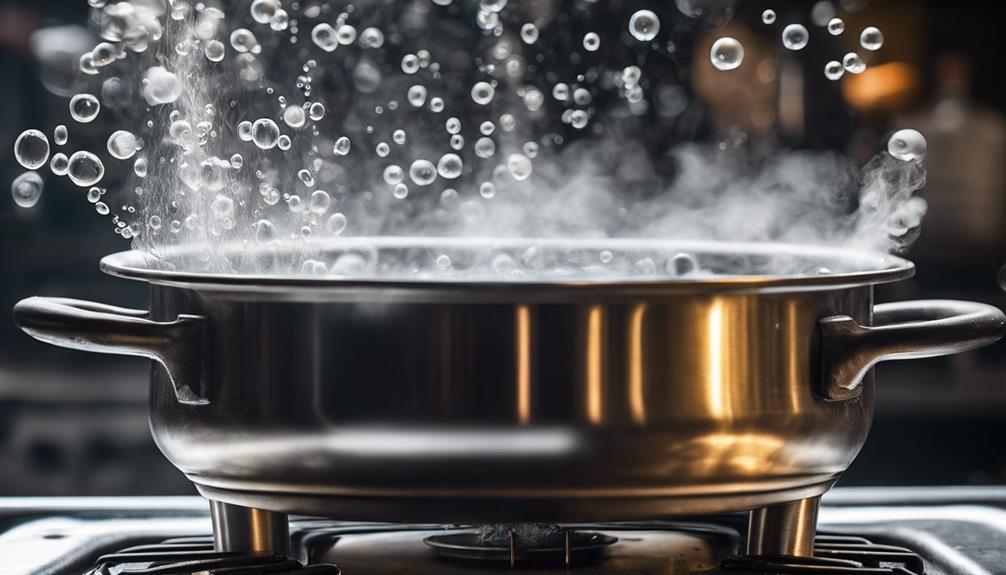
To make ceremonial cacao, heating water to the right temperature is essential for a perfect brew. This guarantees that the cacao melts properly, influencing the flavor and consistency of the final drink.
Using a thermometer can help you achieve the ideal 170 degrees Fahrenheit for a smooth and delicious ceremonial cacao experience.
Water Temperature Importance
Heating the water to 170 degrees Fahrenheit is essential for achieving the desired consistency in ceremonial cacao preparation. Proper water temperature is critical for extracting the flavors and benefits of the cacao. Here's why the water temperature matters:
- Smooth Consistency: Ideal water temperature helps in properly melting the cacao for a smooth texture.
- Full Dissolution: Heating water to the desired temperature guarantees the cacao is fully dissolved.
- Enhanced Taste and Texture: Water temperature impacts the overall taste and texture of the ceremonial cacao drink.
Maintaining the correct water temperature is a key step in creating a delicious and satisfying ceremonial cacao experience.
Achieving Perfect Heat
Maintaining the correct water temperature is key to achieving the perfect heat for ceremonial cacao, ensuring ideal flavor extraction and consistency.
To reach the desired 170 degrees Fahrenheit, start by heating water in a pot over medium heat. Once it begins to steam and tiny bubbles appear at the bottom of the pot, use a thermometer to monitor the temperature closely.
Avoid overheating, as boiling water can alter the cacao's taste. Once the water reaches the ideal temperature, remove it from the heat source promptly.
This precise water temperature is essential for revealing the full flavors and benefits of ceremonial cacao, providing a consistent and delightful experience with each sip.
Select Cacao Dosage Mindfully
When preparing ceremonial cacao, it's important to choose the dosage mindfully. Consider the effects of the cacao, ranging from heart-warming to profound experiences.
Your personalized dose selection will influence the intensity and overall experience of the ceremony.
Cacao Dosage Importance
Selecting the appropriate dosage of ceremonial cacao is fundamental for a meaningful and transformative cacao ceremony experience. When it comes to cacao dosage, remember these key points:
- The recommended ceremonial dose of cacao is typically around 25g per person, though some suggest using 42g for a more potent experience.
- There isn't a one-size-fits-all ceremonial dose; the effects vary based on personal preferences and intentions.
- Mindfully choosing the right amount of ceremonial cacao is vital for experiencing the heart-warming and profound effects of a cacao ceremony.
Properly weighing and measuring the cacao guarantees a balanced and impactful ceremonial drink, enhancing the spiritual and transformative aspects of the ceremony.
Mindful Consumption Considerations
Mindfully considering the appropriate dosage of ceremonial cacao is essential for a transformative and enriching cacao ceremony experience. When preparing your ceremonial cacao drink, it's important to start with the right amount to fully embrace the heart-warming effects.
For a standard dose, consider using around 25g of ceremonial cacao per person. If you're seeking a more profound experience, some practitioners recommend a dosage of 42g. These carefully selected amounts can enhance the overall impact of your ceremonial cacao journey.
Personalized Dose Selection
To fully engage in a meaningful ceremonial cacao experience, it's essential to contemplate the personalized dose selection thoughtfully. When selecting your cacao dosage for the ceremony:
- Start with a conservative amount and gradually increase if needed for a deeper experience.
- Consider your sensitivity to stimulants and adjust the dose accordingly.
- Listen to your body's responses during the ceremony to gauge the effects accurately.
Finding the right balance of ceremonial cacao for your personalized experience is key to unleashing its full potential. By carefully considering your dosage, you can tailor the ceremony to suit your needs and intentions, allowing for a more profound and enriching journey.
Blend Cacao Discs With Liquid
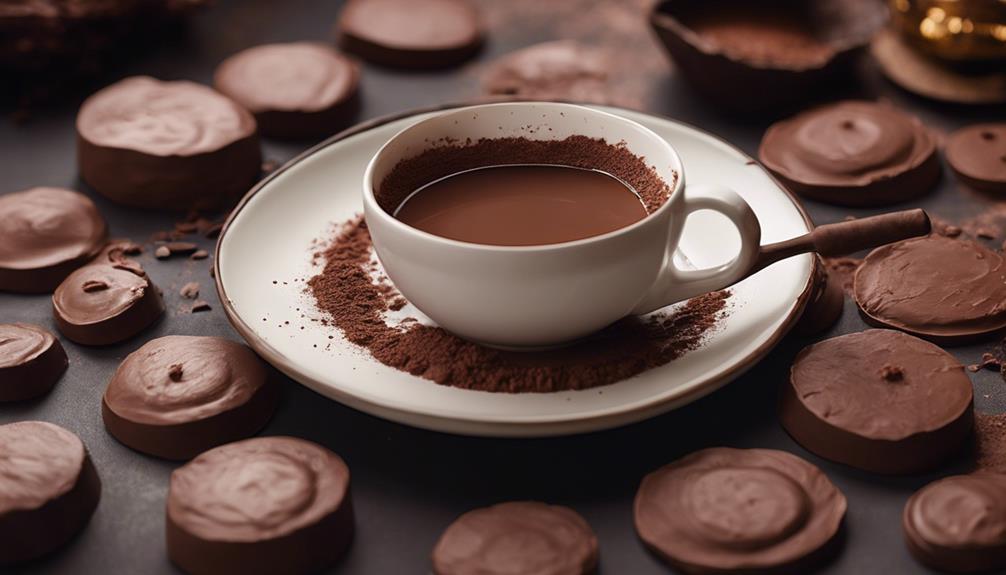
I blend 15-40 cacao discs with 5-6oz of heated liquid to create a creamy ceremonial cacao drink. The cacao discs, rich in plant medicine, are essential for this sacred ritual. The liquid can be water, milk, or even herbal tea, chosen based on your preference.
Heating the liquid helps the cacao discs melt smoothly, infusing the drink with their deep flavors. As I blend them together, I watch as the mixture transforms into a velvety concoction, ready to be savored.
This process of blending isn't just about mixing ingredients; it's about merging energies, creating a harmonious blend of cacao and liquid. The act of blending is a meditative practice, allowing me to connect with the essence of the cacao and prepare it for consumption.
This step sets the foundation for the ceremonial experience, ensuring that every sip is filled with intention and reverence for this ancient plant medicine.
Add Sweetener if Desired
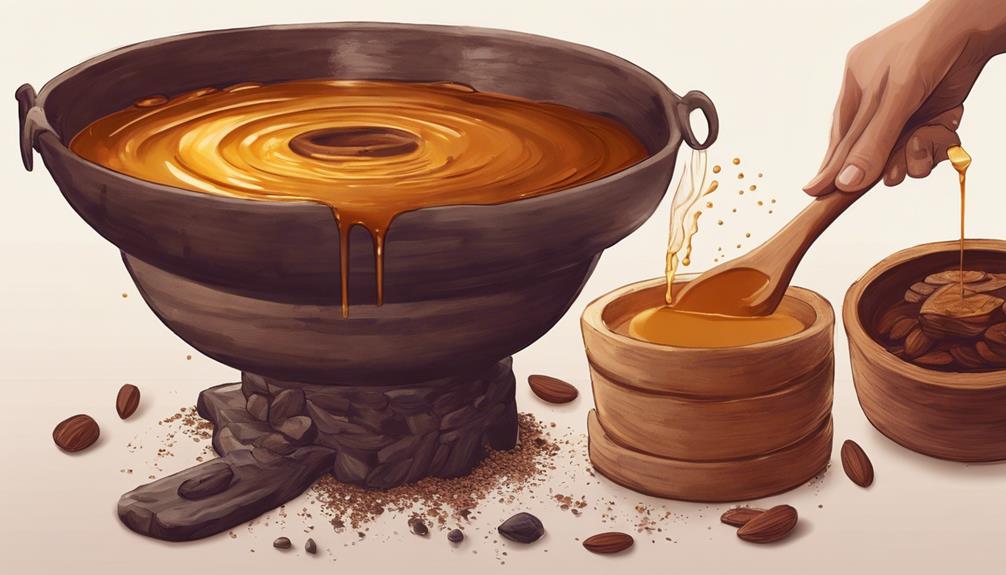
After blending the cacao discs with your chosen liquid, the next step is to enhance the flavor profile by adding a natural sweetener if desired. When it comes to making ceremonial cacao, adding a touch of sweetness can truly elevate the experience. Here are some natural sweeteners you might consider incorporating into your cacao blend:
- Raw Honey: This natural sweetener not only adds a lovely sweetness but also brings its unique flavor profile, enhancing the depth of the cacao.
- Coconut Blossom Sugar: A less refined alternative to traditional sugar, coconut blossom sugar can add a subtle caramel-like sweetness to your ceremonial cacao.
- Sweet Freedom: This natural sweetener made from fruit extracts can provide a delicate sweetness without overpowering the rich taste of the cacao.
Experimenting with these sweeteners can help you find the perfect balance to create a cacao drink that suits your palate. Remember, the sweetness level is entirely up to you, so feel free to adjust it based on your taste preferences.
Set Meaningful Intention Before Sipping
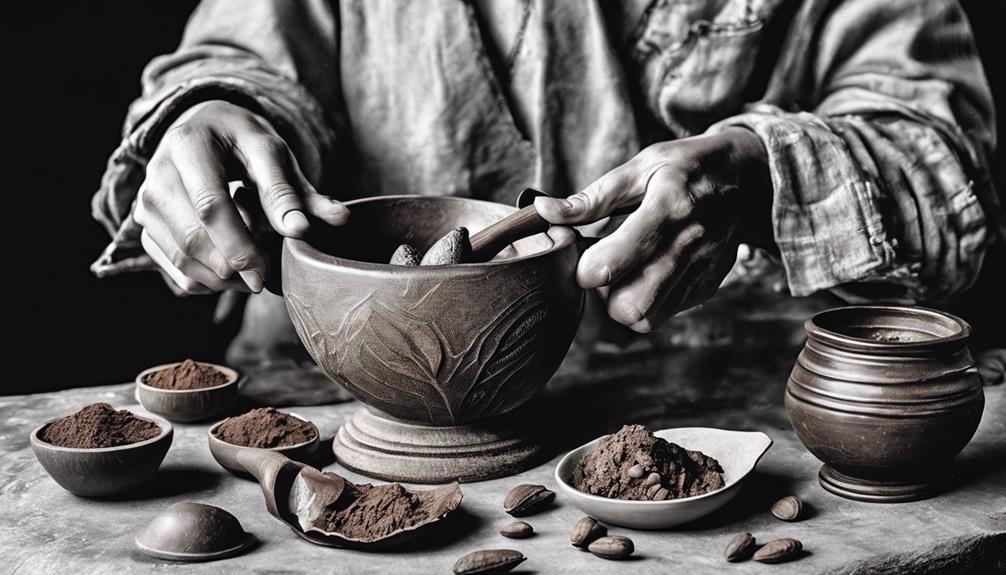
Prior to indulging in your ceremonial cacao, it's crucial to establish a meaningful intention. This process aids in directing your thoughts and emotions throughout the ritual, harmonizing your energy with your objectives.
Intent Clarity Importance
Setting a meaningful intention before sipping ceremonial cacao is essential for amplifying the energy and purpose of the ritual experience. When it comes to intent clarity, here's why it's pivotal:
- Focus Energy: Clarity in intent helps direct the energy flow during the ceremony.
- Purpose Alignment: Setting an intention creates a clear direction for the mind, body, and spirit alignment.
- Transformative Experience: By establishing a purpose, you prepare yourself for a potentially powerful and transformative journey.
Heartfelt Connection Ritual
To enhance the depth of the ceremonial cacao experience, infusing a heartfelt connection ritual by setting a meaningful intention before sipping is a practice that magnifies the ritual's essence.
Before indulging in the rich cacao elixir, take a moment to reflect on your innermost desires. Close your eyes, breathe deeply, and let your intentions flow from the heart onto paper. Writing down your intentions helps focus the mind, bringing clarity to the ceremony. This sacred act creates a space for genuine connection and invites positive energy to envelop you.
Choose intentions that resonate with your personal growth, healing journey, or feelings of gratitude. By setting intentions before sipping ceremonial cacao, you infuse the experience with depth and mindfulness, allowing for a profound connection with yourself and the sacred brew.
Mindful Sip Reflection
Enhancing the ceremonial cacao experience begins with infusing a heartfelt intention before sipping, allowing for a deeper connection to the ritual's essence. Setting a meaningful intention can help focus the mind and bring clarity to the ceremony. Reflecting on this intention while sipping the cacao can deepen the connection to the heart and the ceremony.
Here are some ways intention setting can enhance your ceremonial cacao experience:
- Clarifies your purpose for the ceremony
- Guides your energy towards specific goals
- Amplifies the effects of the cacao on your mind and spirit
Mindful sipping encourages presence and awareness during the cacao ceremony, enriching the spiritual journey you engage in with each sip.
Experience the Rich Flavors Mindfully
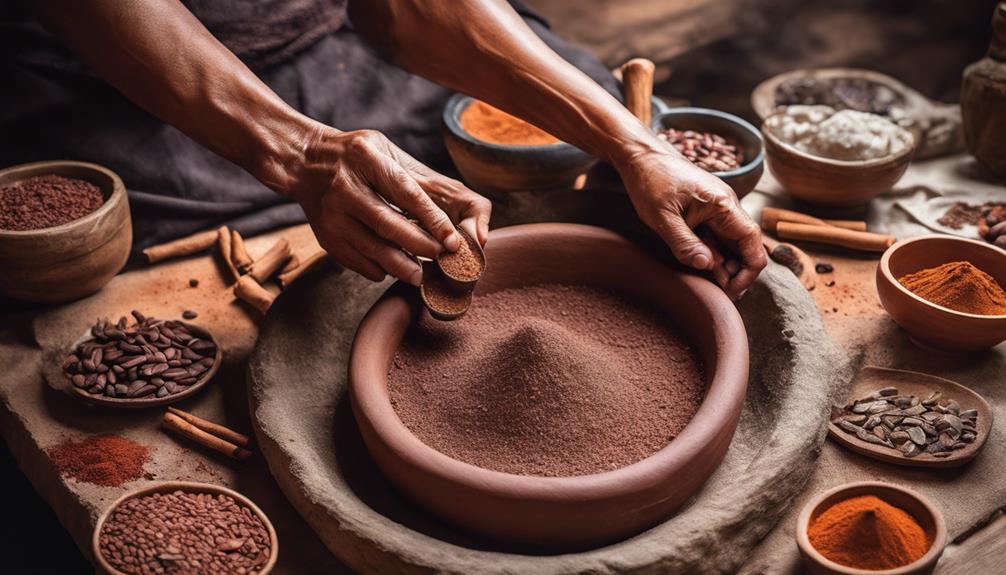
Savoring the rich flavors of ceremonial cacao mindfully can deepen the experience and evoke a sense of connection and warmth. When I take my first sip, I let the velvety texture envelop my senses, allowing the earthy undertones to dance on my palate. To fully appreciate the flavors, I suggest focusing on each sip, noticing the subtle shifts in taste as the cacao unfolds its complexity. Here's a simple guide to help you experience the rich flavors of ceremonial cacao mindfully:
| Step | Description |
|---|---|
| 1. Smell | Inhale deeply to capture the cacao's aroma. |
| 2. Taste | Allow the cacao to linger on your tongue. |
| 3. Feel | Notice the warmth spreading through your body. |
Engaging with ceremonial cacao in this way can elevate your day-to-day experience, turning a simple act of drinking into a ritual of connection and presence.
Embrace the Benefits of Ceremonial Cacao
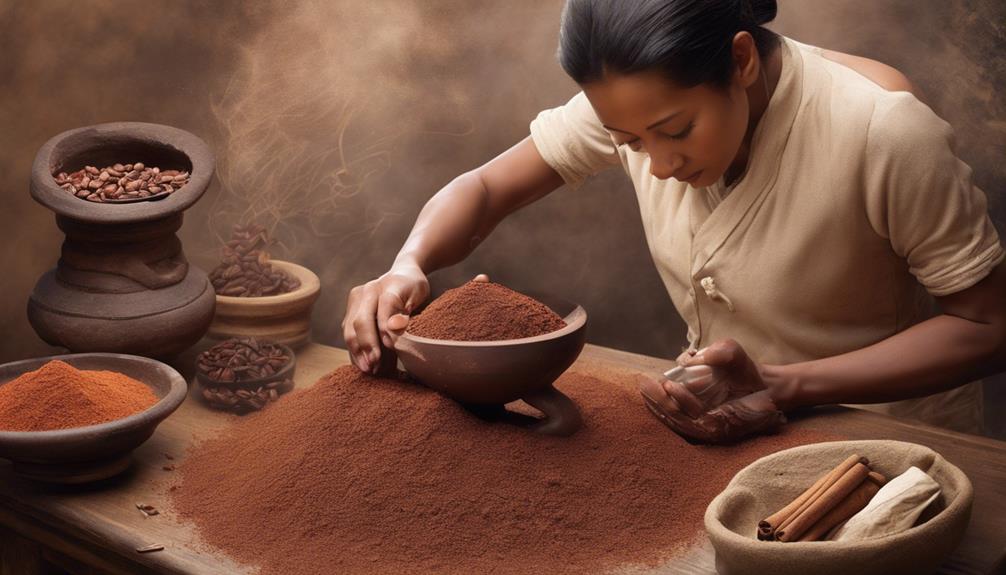
Embracing the benefits of ceremonial cacao brings about a sense of heart-opening and profound effects. When you open yourself to the magic of ceremonial cacao, you'll experience:
- Enhanced meditation practices: Ceremonial cacao has been known to deepen meditation experiences, allowing for a more profound connection to your inner self.
- Increased creativity: The heart-opening properties of ceremonial cacao can stimulate creativity, helping you tap into new ideas and inspiration.
- Improved energy and focus: Consuming ceremonial cacao can lead to a boost in energy levels and a heightened sense of focus, especially centered around the heart space.
Reflect on Your Cacao Ceremony
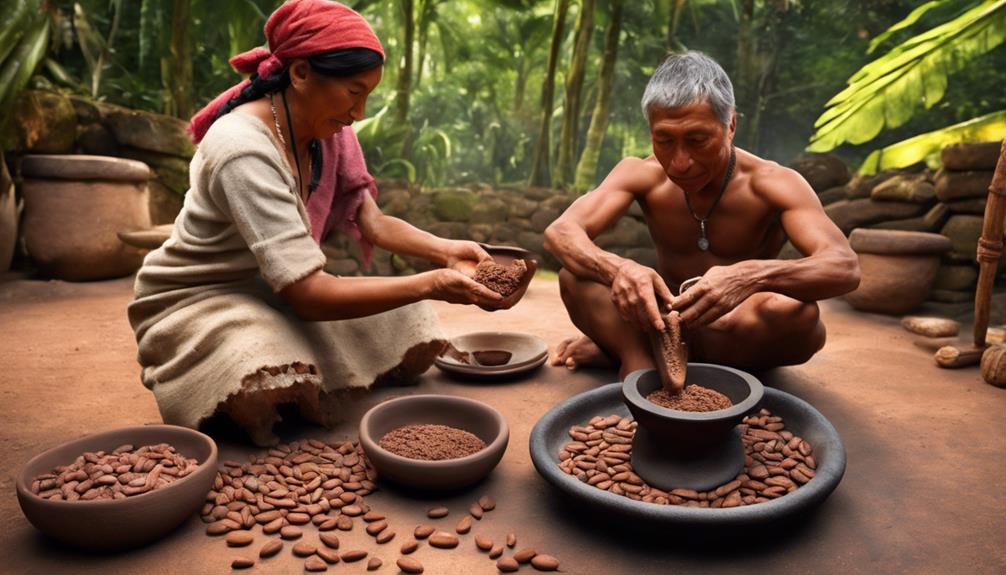
As I reflect on the recent cacao ceremony, it's vital to explore the profound effects it had on my overall well-being and state of mind. Taking time to ponder the experience can help integrate the insights gained and understand the impact of the ceremonial cacao on different aspects of my being.
| Aspects to Reflect On | Notes |
|---|---|
| Physical | Felt energized and nourished |
| Mental | Experienced clarity and focus |
| Emotional | Emotions of gratitude and peace |
| Messages/Guidance | Received insights on self-care |
Recording in a journal about these aspects can help capture the emotions, thoughts, and intentions during the ceremony. It's fundamental to give thanks for the experience and any messages or guidance received. Evaluating how the ceremonial cacao made me feel physically, mentally, and emotionally allows for a deeper understanding of the impact it had on my overall well-being.
Share Your Ceremonial Cacao Journey
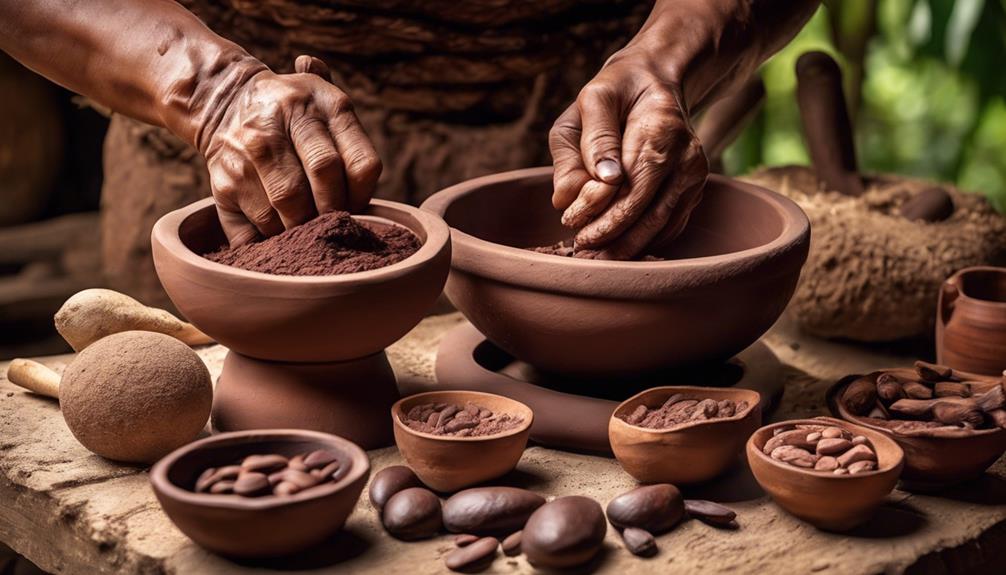
Reflecting on the transformative power of preparing and consuming ceremonial cacao has been an enlightening journey. Sharing my ceremonial cacao journey has allowed me to connect more deeply with the ritual and its benefits. Here are some insights I've gained along the way:
- Emotional Release: The ceremonial cacao has helped me release built-up emotions and tensions, allowing me to feel more relaxed and at peace.
- Connection to Self: Through this practice, I've developed a deeper connection to my inner self, fostering self-awareness and mindfulness.
- Nervous System Support: I've noticed that the ceremonial cacao has a calming effect on my nervous system, helping me feel more grounded and centered in my daily life.
Sharing your own ceremonial cacao journey can't only deepen your experience but also inspire others to explore the profound effects this ritual can have on both mind and body.
Frequently Asked Questions
How to Do a Cacao Ceremony Step by Step?
To do a cacao ceremony step by step, I connect with the cacao essence, set intentions, and honor the sacredness of the ritual. I mindfully prepare the cacao, infusing love and gratitude into each step for a soulful experience.
How Is Ceremonial Cacao Made?
Brewing ceremonial cacao is like crafting a warm hug in a cup. I gently warm milk, add ceremonial cacao, whisk until melted, and pour it into a special cup. Sweeteners and spices can elevate this sacred experience.
How Many Tablespoons of Cacao for Ceremonial?
For a ceremonial experience, I typically use 42g (around 3 tablespoons) of cacao per person. Adjust based on personal preference and intention. Start with a moderate amount and increase as desired for a heart-warming experience.
How Much Water Do You Need for Ceremonial Cacao?
I usually go for 100-200ml of water or milk for my ceremonial cacao. The amount of water impacts the richness; less water means a stronger flavor, more for a milder taste. Experiment to find your ideal balance.
Is a Shortcut Method for Making Cacao Just as Effective for Ceremonial Purposes?
Yes, you can make cacao in 3 steps and still have an effective ceremonial experience. The key is to use high-quality cacao and to focus on your intention and mindset while making and drinking the cacao. The simplicity of the method does not diminish its effectiveness for ceremonial purposes.
Conclusion
Now that you've learned how to make ceremonial cacao in 10 steps, it's time to experience the magic for yourself. The rich flavors, benefits, and mindful ceremony await you.
So gather your ingredients, heat your water, and blend with intention. Embrace the journey of ceremonial cacao and let it transport you to a place of reflection and connection.
Share your experience with others and continue to explore the world of this ancient ritual.

